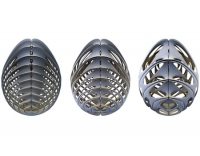Cross Scalar Variation II
"Versioning: Parametric Prototypes"
This project investigates the role of versioning in contemporary theory and the practice of design. The introduction of computation in architecture allowed for complex mathematical calculations and their visualization, which were for a long time simply too complex. Today, differential calculus – underlying most interactive 3D modeling software – has significantly informed the production and conceptualization of architecture.
The upshot of this transformation is that we are now witnessing a shift from an architecture of modularity towards an architecture of seriality. The core idea of versioning exceeds simple variation between different parameterized design iterations; Versioning rather also operates at the micro-scale, within the structure and aesthetic of the digital design itself.
With the introduction of digital media, the conception of modularized architecture constructed out of nearly identical industrially mass-produced components, and thus Gropius’ thesis, that “The creation of [standardized] types […] is an effective tool to create better and cheaper with industrial production a new manifold of products,” has been challenged. Today, with the use of the computer and calculus-based software, architecture can instead be realized as parametric prototypes of a series.
A series is a framework of parameters designed by the architect, within which a variety of design versions may be realized. Each of these design versions is unique and yet also part of the series. The parts assembling each of the series’ designs are no longer necessarily mass-produced but could rather be mass customized. Our work furthermore calls for a critical assessment of differential calculus and its potential to challenge traditional modes of designing, producing, and constructing architecture and its milieu.
Project Title: “Cross Scalar Variation Studies II - Versioning: Parametric Prototypes”
Design year: 2009
Type: Research Study



